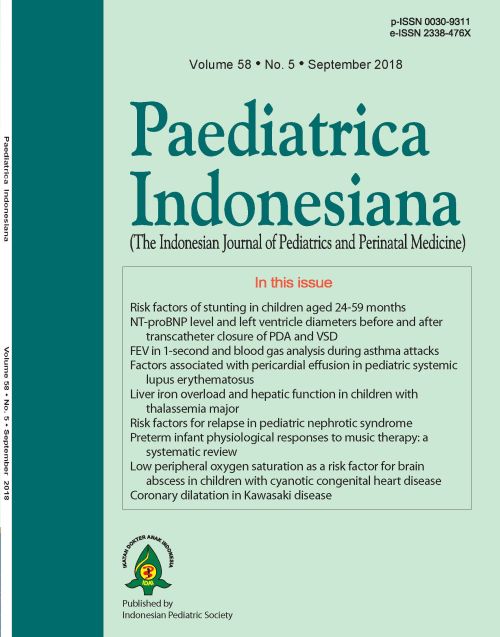Low peripheral oxygen saturation as a risk factor for brain abscess in children with cyanotic congenital heart disease
Abstract
Background Brain abscess is a severe infection of brain parenchyma, which occurs in 25-46% of cases of uncorrected cyanotic congenital heart disease. Low arterial oxygen saturation is the main risk factor for brain abscess in children with cyanotic congenital heart disease, however, the arterial oxygen saturation test is invasive and not routinely done in our setting.
Objective To evaluate low peripheral oxygen saturation as a risk factor for brain abscess in children with cyanotic congenital heart disease.
Methods We conducted a matched, case-control study at Sardjito Hospital, Yogyakarta for children aged less than 18 years with cyanotic congenital heart disease, from 2010-2016. Case subjects were children with brain abscess complications. The control group had only cyanotic congenital heart disease, and were matched for age and sex to the case group. During hospitalization due to the brain abscess complication in the case group, data regarding peripheral oxygen saturation, polycythemia, pneumonia, sepsis, dental caries and restricted pulmonary blood flow were collected and compared between both groups.
Results During the study period, 18 children with cyanotic congenital heart disease had brain abscesses. This group was compared to the control group of 36 children. Bivariate analysis revealed that the lowest level of peripheral oxygen saturation (OR 0.92; 95%CI 0.85 to 0.98; P=0.02) and dental caries (OR 3.3; 95%CI 1.01 to 11.18; P=0.04) were significant risk factors for brain abscess. However, in the multivariate analysis, the only statistically significant risk factor associated with brain abscess was the lowest level of peripheral oxygen saturation (OR 0.92; 95%CI 0.86 to 0.99; P=0.04).
Conclusion Low peripheral oxygen saturation is a significant risk factor for brain abscess development in children with cyanotic congenital heart disease. A decrease of 1% peripheral oxygen saturation may increase the risk of brain abscess by 8%.
References
2. Ozsurekci Y, Kara A, Cengiz AB, Celik M, Ozkaya-Parlakay A, Karadag-Oncel E, et al. Brain abscess in childhood: a 28-year experience. Turk J Pediatr. 2012;54:144-9.
3. Malik S, Joshi SM, Kandoth PW, Vengsarkar US. Experience with brain abscesses. Indian Pediatr. 1994;31:661-6.
4. Kao KL, Wu KG, Chen CJ, Wu JJ, Tang RB, Chang KP. Brain abscesses in children: analy-sis of 20 children presenting at a medical center. J Microbiol Immunol Infect. 2008;41:403-7.
5. Fischbein CA, Rosenthal A, Fischer EG, Nadas AS, Welch K. Risk factors for brain abscess in patients with congenital heart disease. Am J Cardiol. 1974;34:97-102.
6. Takeshita M, Kagawa M, Yonetani H, Izawa M, Yati S, Nakanishi T, et al. Risk factors for brain abscess in patients with congenital cyanotic heart disease. Neurol Med Chir. 1992;32:667-70.
7. Lee CG, Kang SH, Kim YJ, Shin HJ, Choi HS, Lee JH, et al. Brain abscess in Korean chil-dren: a 15-year single center study. Korean J Pediatr. 2010;53:648-52.
8. Prusty GK. Brain abscesses in cyanotic heart disease. Indian J Pediatr. 1993;60:43-51.
9. Van de Louw A, Cracco C, Cerf C, Harf A, Duvaldestin P, Lemaire F, et al. Accuracy of pulse oximetry in the intensive care unit. Intensive Care Med. 2001;27:1606-13.
10. World Health Organization. Pulse oximetry training manual. Geneva: World Health Or-ganization; 2011. p.13
11. Vallee L, Pinton F, Martin BH, Debray P, Vamecq J, Hladky JP, et al. Brain abscess com-plicating dental caries in children. Arch Pediatr. 1994;1:166-9.
Copyright (c) 2018 Nadia Qoriah Firdausy, Indah Kartika Murni, Agung Triono, Noormanto Noormanto, Sasmito Nugroho

This work is licensed under a Creative Commons Attribution-NonCommercial-ShareAlike 4.0 International License.
Authors who publish with this journal agree to the following terms:
Authors retain copyright and grant the journal right of first publication with the work simultaneously licensed under a Creative Commons Attribution License that allows others to share the work with an acknowledgement of the work's authorship and initial publication in this journal.
Authors are able to enter into separate, additional contractual arrangements for the non-exclusive distribution of the journal's published version of the work (e.g., post it to an institutional repository or publish it in a book), with an acknowledgement of its initial publication in this journal.
Accepted 2018-10-15
Published 2018-10-17













